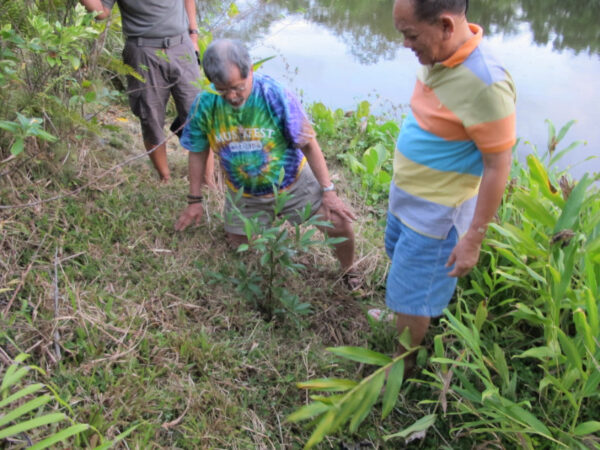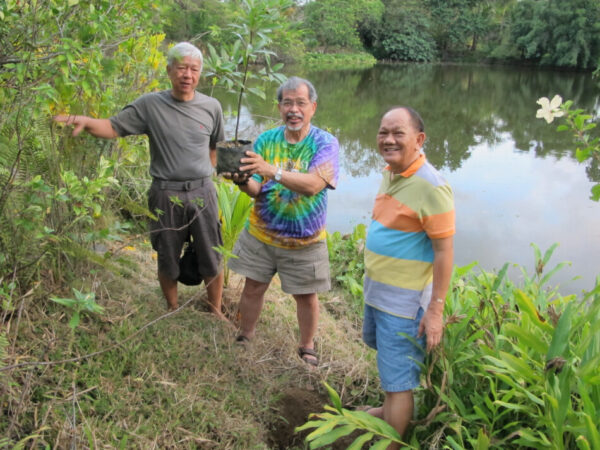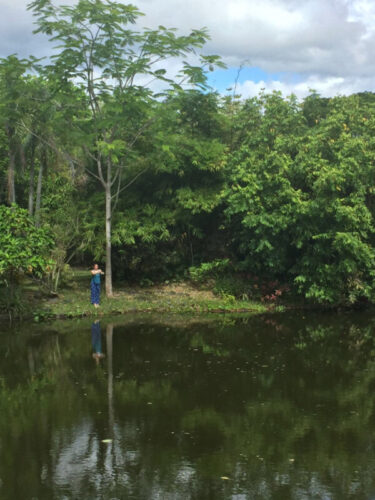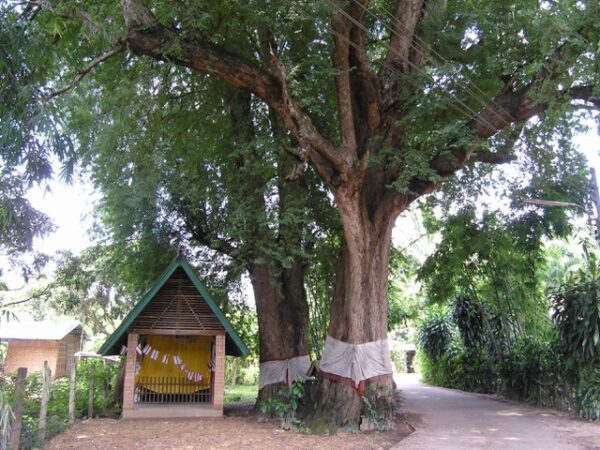I was scrolling down the files when I saw this photograph of two giant tamarind trees just outside the Tao Garden in Doi Saket, Chiang Mai, Thailand. I do not how old they are. Perhaps 100 years? I also have a photo somewhere of 2 gingko trees in the Shaolin Temple in Loyang, Hunan Province that were, according to the plaque, at least 1000 years old.
In some countries, trees are considered sacred and harbor spirits. Offerings of candles, food and incense are made to them. Aside from their ecological value, trees are actually worshipped in certain cultures or at least they are considered having an identity or a “personhood,” i.e., they are not just objects that you could chop down as you wish when you need the space for fuel, building or road expansion. In Hawaii, there was an old tree that “stood in the way” of a commercial mall. Instead of simply being cut down, it was carefully dug up and transferred to another place. In the Philippines, when the Global City in Makati was built, many old acacia trees were curt down. Every time I pass that way I feel their absence and imagine the power saws buzzing them into oblivion. I have a practice of “connecting” with trees drawn from the Daoist alchemical meditations of Mantak Chia. David Verdesi also taught me a regimen that I use at sunrise and sunset whenever I am in the vicinity of a giant pine tree in the park behind my house. James McConnell, a disciple of Wang Liping, also has a practice with a particular tree in the Tao Garden; he and I sat in the shadow of the tree when I visited him Thailand.
My friend and colleague Vic Ramos invited me 10 years ago to plant a kupang tree by the pond in his farm in Natividad, Pangasinan. Vic, the former Environmental and Natural Resources Secretary, has a collection of at least 100 endemic and indigenous trees. The sapling has grown at least 30 feet high. The tree is now a giant! According to Vic, the tree is a “Kupang or drumstick tree , scientific name Parkia timoriana. Its bark is med for scabies, boils or abscesses. Young leaves are edible.”
Here are photos showing the tree from the time it was planted to its height 2 years ago.
On a similar subject, here is a piece about the 100 bananas planted by, well, the Banana Club in the campus of the University of the Philippines. The Banana Club was a pioneer group that was founded by students in the early 1960s. According to them the banana, not the apple, is the true Fruit of the Wise mentioned in Genesis.
Diliman as ‘Banana Republic?’
By HERN P. ZENAROSA
WHILE academic denizens of the University of the Philippines caroused tumultuously in celebration of its centennial year, a motley group quietly plotted to assert a new vision of the Diliman community.
On January 18, 2008, a Wednesday, the campus cabal calling itself “The Banana Club” (TBC), erected monuments to the coming “Age of Wisdom,” exactly 100 seedlings of the “Fruit of the Wise” consisting of 20 seedlings each of lakatan, lagkitan, liturdan, saba, and bungulan. The banana is scientifically known as Musa paradisiacal, linking the tree to the biblical myth of Adam and Eve partaking of the fruit of knowledge when both were still in paradise.
The 100 seedlings were planted in a garden beside the UP Alumni Association Hostel, not far from the Bahay ng Alumni building. The wellplaced young plants have been attracting groups of people watching the beautiful Diliman sunset.
Having thus achieved what its members consider sizeable terra firma in Diliman, the Club forthwith declared Diliman as “The Republic of the Bananas.”
The planting ritual, according to one of TBC’s driving force, former Department of Environment and Natural Resources Secretary Victor O. Ramos, was meant to combat climate change. Trees and any greenery are thought to effectively absorb carbon dioxide from the air in the roots of the plants, he said.
The Banana Club is made up of men who think like men of action and act like men of thought. Among its ranks, according to a member, Lawyer Frankie Llaguno, was the first President of the United Nations General Assembly, a United Nations Undersecretary General, a Senate President of Micronesia, top lieutenants of the Food and Agriculture Organization, the UN Population Fund, several Cabinet members holding portfolios such as Environment, Education, NEDA, Agrarian Reforms, Ambassadors, UNDP heads, and bar topnotchers.
TBC’s politics is inclusive, another club member, Vic de Jesus says, many of whom have served under Marcos, Cory, Eddie, Erap, and Gloria: A member was once head of the National Democratic Front while another heads the Christian Democratic and Muslim Party, but most are non-partisan.
De Jesus went on to explain that the nationalities of members are universal although, of course, the majority are Filipinos but the memberships represent Micronesia, Canada, India, and Japan. They also represent various interests and disciplines: Economists, artists, journalists, university professors, political operatives and tacticians, historians, essayists, and an international martial arts guru.
Of all the societies that swarm in the history of UP, Vic Ramos said, TBC has the most number of Collegian editors, columnists, and writers.
Looking back, Llaguno recalls TBC came to existence during the golden years of UP under the presidency of Gen. Carlos P. Romulo in the ‘60s. The elite group which was very secretive about its recruitment process, became the object of campus wonder and mystery: Its members were active in campus life, in campus journalism, politics, oratorical and debating jousts, and in almost all aspects of campus activism. They were true to their motto of “The penetration of veiled ignorance and injecting vitality to our lives.” Its abiding maxim is, Tere atqui rotundas(Smooth and round, polished and complete, said a wise man).
The TBC roster includes Gen. Carlos P. Romulo, Rafael M. Salas, Lito Imperio, Agustin Que, Boy Morales, Jimmy Yambao, Tosi Nakamura, Ed Nacpil, Fred Clemente, Buddy Carlota, Chibu Lagman, Rene Navarro, Frankie Llaguno, Vic Ramos, Joe Molano, Bani Aguirre, Vic de Jesus, Joji Feraren, Hari Sidhu, Chet Tan, Ben Pires, Temy Rivera, Franklin Osorio, Wahlee Rodriguez, Gari Tiongco, Angie Fandialan, Poch Macaranas, Buddy Garbanzos, Fort Yerro, Melvyn Viray, Sonny Alvarez, Vic Tirol, Safish Mehra, Sigeaki Tomita, Mat Defensor, Frey Cabading, and Nelson Navarro.
By the sound of their names, you immediately conjure the Bananas were men of wit and winning says. They were and are achievers ne plus ultra, men of highest achievements.
So, as the Diliman commune look forward to the next hundred years, The Banana Club has opened the way towards achieving “The Age of Wisdom,” pointing to the truth that knowledge by itself is not enough; it is how we act according to what we know that homo sapiens can best achieve its perfection and hopefully save our endangered planet.



